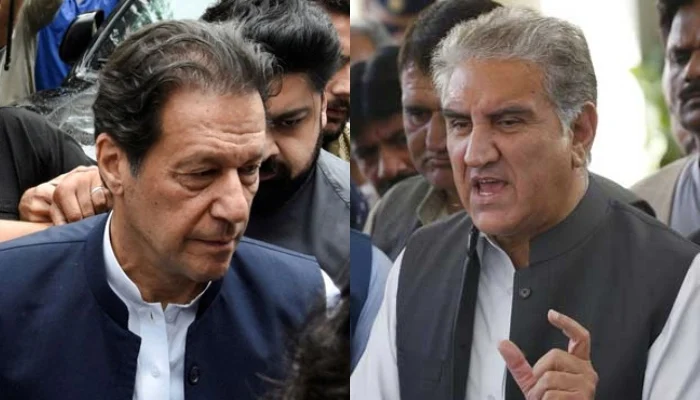A special court on Wednesday extended Pakistan Tehreek-e-Insaf (PTI) Chairman Imran Khan and Vice Chairman Shah Mahmood Qureshi’s judicial remand in cipher case till September 26.
Khan has been imprisoned in the jail since his conviction in the Toshakhana case on August 5 for failing to properly declare gifts he received while in office.
While the Islamabad High Court had overturned a lower court’s decision to jail him for three years with a Rs100,000 fine — a judgment that kept him from contesting upcoming elections, he remains behind bars due to his arrest in the cipher case.
The FIA had officially arrested the former prime minister in the cipher case last month after booking him under the Official Secrets Act.
Qureshi was taken into custody from his residence in Islamabad in the same case on August 19 while Khan was arrested in the cipher case while he was serving a three-year sentence in Attock jail in the Toshakhana case last month.
“Consequent upon the conclusion of the enquiry No. 111/2023 dated 05.10.2022, registered in the CTW, FIA Islamabad, it transpired that former prime minister namely Imran Ahmad Khan Niazi, former foreign minister namely Shah Mahmood Qureshi and their other associates are involved in communications of information contained in secret classified document (Cipher Telegram received from Parep. Washington dated 7th March, 2022 to Secretary Ministry of Foreign Affairs) to the unauthorised person (i.e. public at large) by twisting the facts to achieve their ulterior motives and personal gains in a manner prejudicial to the interests of state security,” read first information report (FIR) registered against the PTI leaders.
The Law Ministry had established the special court under the Official Secrets Act to conduct hearing on cipher case and anti-terrorism court (ATC) Judge Zulqarnain was given an additional charge to hear the matter.
A day earlier. the IHC reserved its verdict on Khan’s petition challenging the Law Ministry’s notification to hold his trial in Attock jail citing security concerns.
Cable gate
The controversy first emerged on March 27, 2022, when Khan — just days before his ouster in April 2022 — brandished a letter, claiming that it was a cipher from a foreign nation, which mentioned that his government should be removed from power.
He did not reveal the contents of the letter nor mention the name of the nation that had sent it. But a few days later, he named the United States and said that Assistant Secretary of State for South and Central Asia Affairs Donald Lu had sought his removal.
The cipher was about former Pakistan ambassador to the US Asad Majeed’s meeting with Lu.
The former prime minister, claiming that he was reading contents from the cipher, said that “all will be forgiven for Pakistan if Imran Khan is removed from power”.
Then on March 31, the National Security Committee (NSC) took up the matter and decided to issue a “strong demarche” to the country for its “blatant interference in the internal affairs of Pakistan”.
Later, after his removal, then-prime minister Shehbaz Sharif convened a meeting of the NSC, which came to the conclusion that it had found no evidence of a foreign conspiracy in the cipher.
The cipher case against the former premier became serious after his principal secretary Azam Khan stated before a magistrate as well as the Federal Investigation Agency (FIA) that the former PM had used the US cipher for his ‘political gains’ and to avert a vote of no-confidence against him.
The former bureaucrat, in his confession, said when he provided the ex-premier with the cipher, he was “euphoric” and termed the language a “US blunder”. The former prime minister, according to Azam, then said that the cable could be used for “creating a narrative against establishment and opposition”.
Azam said the US cipher was used in political gatherings by the PTI chairman, despite his advice to him to avoid such acts. He mentioned that the former prime minister also told him that the cipher could be used to divert the public’s attention towards “foreign involvement” in the opposition’s no-confidence motion.




